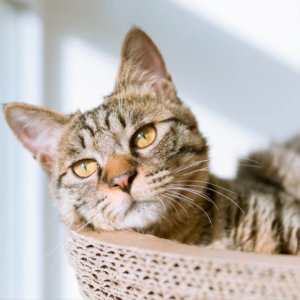Many of us struggle to keep our own weight in check over the long winter months and our four legged friends are no different. It’s easy to let exercise fall by the wayside when the mercury drops below freezing but your pet does not hibernate, and it’s important that your pet gets daily exercise. Exercise is vital for a pet’s physical and mental wellness. On those days when just the thought of playing outside makes you shiver, you can still give your pet the exercise that it needs to stay healthy. Don’t forget your feline friends. They can benefit from similar tips, where needed, we will include a feline adaptation. Here are our best exercise and nutrition tips for a Canadian winter.
Have Fun with Your Pet!
Don’t confuse eating with pleasure for a dog or cat. They get the same, if not more enjoyment, out of going for a walk or playing with you than eating a treat.
Still want to give treats – of course that’s ok but just be sure to factor it into their daily calorie allotment. Even the little things like licking the plate clean still count! Ask a staff member to find out your pet’s personal daily limit.
Better yet make them work for their measured meals and treats. Here are some food based activities:
Stairs – Place kibbles on each step going up then down again until their entire meal is gone.
Fetch – Toss the kibbles around the room and have your pet chase them down.
Buster cubes/puzzle balls – Stimulate their mind as well with a toy where you put the food inside and they have to work to get them out.
Training – Use their meal to teach them new tricks. Another one that is great for mind and body!
The amount of time you spend outside with your dog will depend on his size, breed and age. Remember that ill or elderly pets are more sensitive to cold weather. Dogs should not be left outside unattended. Make sure your dog is warm, for some breeds that will mean winter cloths such coats or boots. Don’t forget water as they still need to stay hydrated, even in cold weather.
Walk mid-day – Try to get a walk in earlier in the day- utilize the sun’s warmth as much as possible. Watch for slippery sidewalks if the snow/ice thaws. Wipe paws after to remove salt.
Stairs – With or without a leash lead your dog up and down the stairs. For a cat- a toy may be useful for them to chase up and down the stairs.
Skijoring – A combination of cross-country skiing and mushing, this is the ultimate winter workout for dogs and their owners. The dog is harnessed to the owner, and as the dog pulls, the owner uses the skis and poles to steer. This is an advanced activity. Your dog should complete basic training and you should get advice from an expert in the sport.
Take walks in wooded areas – The trees and vegetation will help block the cold wind while walking your dog. Stick to trails and be safe while in this environment.
Indoor training classes – There are classes for all levels. Check your local facilities for information. Cat agility is also available in most communities.
Doggie Daycare – Your dog will get to play both outdoors and indoors, off leash, with other dogs. Usually space is limited during the winter- book early.
Pet treadmills and indoor walking – pet sized treadmills are available or you can use a human one just start slow and always monitor closely. Some arenas or other local facilities, such as pet physiotherapy centers, will allow you to walk your dog indoors just give them a call to find out.
Play a game with your pet – Fetch, hide and seek (with yourself or hide a treat in different places and encourage them to find them), tug of war, chase a laser pointer, which ever game appeals to your pet the most.
For more information contact Clappison Animal Hospital and talk with one of the staff. Stay warm and have fun!




